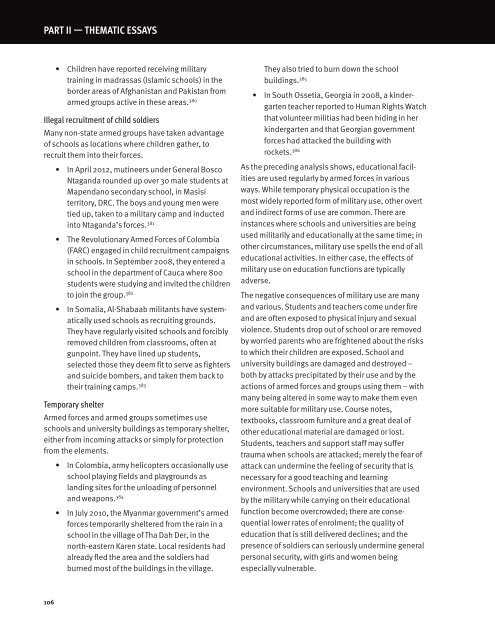Create successful ePaper yourself
Turn your PDF publications into a flip-book with our unique Google optimized e-Paper software.
PART II — THeMATIC eSSAYS<br />
• Children have reported receiving military<br />
training in madrassas (Islamic schools) in the<br />
border areas of Afghanistan and Pakistan from<br />
armed groups active in these areas. 380<br />
Illegal recruitment of child soldiers<br />
Many non-state armed groups have taken advantage<br />
of schools as locations where children gather, to<br />
recruit them into their forces.<br />
• In April 2012, mutineers under General Bosco<br />
Ntaganda rounded up over 30 male students at<br />
Mapendano secondary school, in Masisi<br />
territory, DRC. The boys and young men were<br />
tied up, taken to a military camp and inducted<br />
into Ntaganda’s forces. 381<br />
• The Revolutionary Armed Forces of Colombia<br />
(FARC) engaged in child recruitment campaigns<br />
in schools. In September 2008, they entered a<br />
school in the department of Cauca where 800<br />
students were studying and invited the children<br />
to join the group. 382<br />
• In Somalia, Al-Shabaab militants have systematically<br />
used schools as recruiting grounds.<br />
They have regularly visited schools and forcibly<br />
removed children from classrooms, often at<br />
gunpoint. They have lined up students,<br />
selected those they deem fit to serve as fighters<br />
and suicide bombers, and taken them back to<br />
their training camps. 383<br />
Temporary shelter<br />
Armed forces and armed groups sometimes use<br />
schools and university buildings as temporary shelter,<br />
either from incoming attacks or simply for protection<br />
from the elements.<br />
• In Colombia, army helicopters occasionally use<br />
school playing fields and playgrounds as<br />
landing sites for the unloading of personnel<br />
and weapons. 384<br />
• In July 2010, the Myanmar government’s armed<br />
forces temporarily sheltered from the rain in a<br />
school in the village of Tha Dah Der, in the<br />
north-eastern Karen state. Local residents had<br />
already fled the area and the soldiers had<br />
burned most of the buildings in the village.<br />
They also tried to burn down the school<br />
buildings. 385<br />
• In South Ossetia, Georgia in 2008, a kindergarten<br />
teacher reported to Human Rights Watch<br />
that volunteer militias had been hiding in her<br />
kindergarten and that Georgian government<br />
forces had attacked the building with<br />
rockets. 386<br />
As the preceding analysis shows, educational facilities<br />
are used regularly by armed forces in various<br />
ways. While temporary physical occupation is the<br />
most widely reported form of military use, other overt<br />
and indirect forms of use are common. There are<br />
instances where schools and universities are being<br />
used militarily and educationally at the same time; in<br />
other circumstances, military use spells the end of all<br />
educational activities. In either case, the effects of<br />
military use on education functions are typically<br />
adverse.<br />
The negative consequences of military use are many<br />
and various. Students and teachers come under fire<br />
and are often exposed to physical injury and sexual<br />
violence. Students drop out of school or are removed<br />
by worried parents who are frightened about the risks<br />
to which their children are exposed. School and<br />
university buildings are damaged and destroyed –<br />
both by attacks precipitated by their use and by the<br />
actions of armed forces and groups using them – with<br />
many being altered in some way to make them even<br />
more suitable for military use. Course notes,<br />
textbooks, classroom furniture and a great deal of<br />
other educational material are damaged or lost.<br />
Students, teachers and support staff may suffer<br />
trauma when schools are attacked; merely the fear of<br />
attack can undermine the feeling of security that is<br />
necessary for a good teaching and learning<br />
environment. Schools and universities that are used<br />
by the military while carrying on their educational<br />
function become overcrowded; there are consequential<br />
lower rates of enrolment; the quality of<br />
education that is still delivered declines; and the<br />
presence of soldiers can seriously undermine general<br />
personal security, with girls and women being<br />
especially vulnerable.<br />
106


